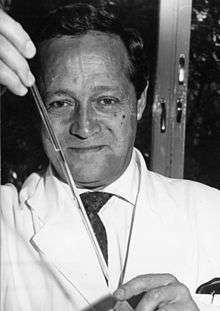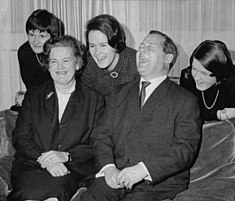Feodor Lynen
Feodor Felix Konrad Lynen ForMemRS[1] (6 April 1911 – 6 August 1979) was a German biochemist. In 1964 he won the Nobel Prize in Physiology or Medicine together with Konrad Bloch for their discoveries concerning the mechanism and regulation of cholesterol and fatty acid metabolism while he was director of the Max-Planck Institute for Cellular Chemistry in Munich.
Feodor Felix Konrad Lynen | |
|---|---|
 | |
| Born | 6 April 1911 |
| Died | 6 August 1979 (aged 68) |
| Nationality | German |
| Awards | Nobel Prize in Physiology or Medicine (1964) Fellow of the Royal Society[1] |
Biography
Feodor Lynen was born in Munich on 6 April 1911. He started his studies at the chemistry department of Munich University in 1930 and graduated in March 1937 under Heinrich Wieland with the work: "On the Toxic Substances in Amanita". Lynen remained in Germany throughout World War II. In 1942 he became a chemistry lecturer at the Munich University. In 1947 he became an assistant professor and in 1953 a professor of biochemistry. From 1954 onwards he was director of the Max-Planck Institute for Cellular Chemistry in Munich, a position which was created for him at the instigation of two senior scientists, Otto Warburg and Otto Hahn. In 1972, that institute was merged into the newly founded Max-Planck Institute of Biochemistry in 1972. Also in 1972, Lynen was named President of the Gesellschaft Deutscher Chemiker (GDCh).[2]
In 1964 he won the Nobel Prize in Physiology or Medicine together with Konrad Bloch for their discoveries concerning the mechanism and regulation of cholesterol and fatty acid metabolism. These discoveries took many years to work out.[3][4][5][6] The Nobel Committee felt that this was important because understanding the metabolism of sterols and fatty acids could reveal how cholesterol affects heart disease and stroke.[7] His Nobel Lecture on 11 December 1964 was 'The pathway from "activated acetic acid" to the terpenes and fatty acids'.[8]
Working mostly separately, Lynen and Bloch both discovered the steps that created squalene and turned the squalene into cholesterol. Initially, Lynen found that acetate activated by Coenzyme A was needed to start the process. He discovered the chemical structure of acetyl-coenzyme A, which was needed for a detailed understanding of the biochemical pathways.[7] He also learned that biotin, or Vitamin B7, was needed for in the process.[8]

On 14 May 1937, Lynen married Eva Wieland (1915–2002), daughter of his academic teacher. They had five children between 1938 and 1946.[2] Feodor Lynen died in Munich, Germany, on 6 August 1979, six weeks after an operation for aneurism.[7]
Fellowship
The Alexander von Humboldt Foundation has a fellowship named in his honor.
Honours and awards
- 1963: Otto Warburg Medal from the German Society for Biochemistry and Molecular Biology [9]
- 1964: Nobel Prize in Physiology or Medicine (with Konrad Bloch) "for their discoveries concerning the mechanism and regulation of the metabolism of cholesterol and fatty acids"
- 1965: Grand Cross of Merit with Star and Sash of the Federal Republic of Germany
- 1967: Norman Medal of the German Society for Fat Research
- 1971: Pour le Mérite for Science and Art
- 1972: Austrian Decoration for Science and Art
References
- Krebs, H.; Decker, K. (1982). "Feodor Lynen. 6 April 1911-6 August 1979". Biographical Memoirs of Fellows of the Royal Society. 28: 261–317. doi:10.1098/rsbm.1982.0012. JSTOR 769901.
- "Feodor Lynen — Biographical". Nobel Media AB. Retrieved 13 November 2013.
- Bucher NL, Overath P, Lynen F (June 1960). "beta-Hydroxy-beta-methyl-glutaryl coenzyme A reductase, cleavage and condensing enzymes in relation to cholesterol formation in rat liver". Biochimica et Biophysica Acta. 40: 491–501. doi:10.1016/0006-3002(60)91390-1. PMID 13805544.
- Lynen F (July 1966). "The biochemical basis of the biosynthesis of cholesterol and fatty acids". Wiener Klinische Wochenschrift (in German). 78 (27): 489–97. PMID 4296920.
- Back P, Hamprecht B, Lynen F (August 1969). "Regulation of cholesterol biosynthesis in rat liver: diurnal changes of activity and influence of bile acids". Archives of Biochemistry and Biophysics. 133 (1): 11–21. doi:10.1016/0003-9861(69)90482-2. PMID 5810824.
- Hamprecht B, Nüssler C, Waltinger G, Lynen F (January 1971). "Influence of bile acids on the activity of rat liver 3-hydroxy-3-methylglutaryl coenzyme A reductase. 1. Effect of bile acids in vitro and in vivo". European Journal of Biochemistry. 18 (1): 10–4. doi:10.1111/j.1432-1033.1971.tb01207.x. PMID 5547468.
- "Feodor Lynen Biography (1911–1979)". Internet FAQ Archives. Retrieved 13 November 2013.
- Lynen, Fyodor (11 December 1964). "The pathway from 'activated acetic acid' to the terpenes and fatty acids". Nobel Media AB.
- "Otto-Warburg-Medal". GBM. Archived from the original on 4 November 2016. Retrieved 12 January 2014.
External links
| Wikimedia Commons has media related to Feodor Lynen. |
- Nobel biography
- Feodor Lynen's Nobel lecture, "The pathway from 'activated acetic acid' to the terpenes and fatty acids"
- Alexander von Humboldt Foundation, Feodor Lynen Research Fellowships
